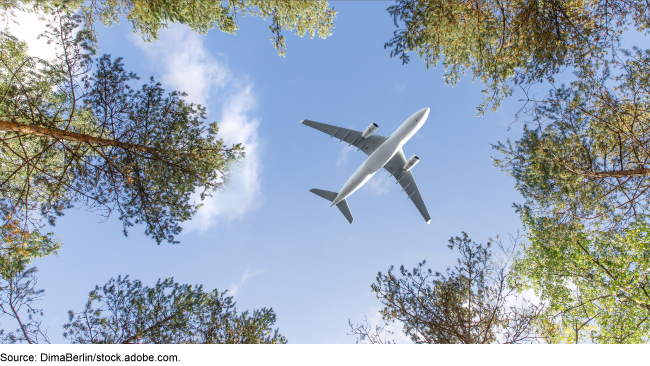Aircraft Noise: FAA Should Improve Efforts to Address Community Concerns
Fast Facts
Airports provide transportation access to communities, but aircraft noise can be disruptive. We testified that despite technological advances leading to quieter airplanes, aircraft noise is still a problem for some communities.
The Federal Aviation Administration assesses how airplane noise affects communities and conducts public outreach to address concerns. But communities could benefit from FAA sharing more information to help them better understand noise issues, such as how flight path changes could affect noise levels.
FAA is taking steps to implement our recommendations, such as improving community engagement and information sharing.

Highlights
What GAO Found
Although advances in technology have led to increasingly quieter airplanes, community concerns about aircraft noise have persisted. One concern relates to FAA's implementation of performance-based navigation (PBN), which may concentrate aircraft noise over a smaller area. As part of its effort to modernize air traffic control, FAA has been implementing PBN to allow aircraft to fly more precise flight paths intended to reduce flying time, fuel use, and emissions. Although, over time, FAA has increased its community outreach efforts throughout the PBN implementation process, FAA could improve its outreach to communities about noise concerns both before and after PBN changes.
In particular, FAA uses the Day-Night Average Sound Level (DNL) metric to meet legal requirements in assessing how these more precise flight paths might affect noise levels at various locations surrounding airports. However, this metric does not provide a clear picture of the flight activity or noise levels at a given location. DNL takes multiple components of aircraft noise into account, including the amount of noise from each flight and the average number of flights per day at a given location. Because of this, the same DNL may be associated with vastly different numbers of flights above that location. Small numbers of relatively loud operations, for example, can result in the same DNL as large numbers of quieter operations, as shown below. As a result, information on potential noise impacts FAA provided during outreach efforts—which was grounded in DNL—was not clear enough for communities to understand the planned changes.

Furthermore, after implementing PBN, FAA primarily conducts outreach through community forums established to address noise concerns. However, members of some forums GAO spoke with were frustrated and unclear on how to productively engage with FAA to address noise concerns. FAA had provided some public guidance on this process, but it was unclear about the extent to which communities can expect assistance from FAA in proposing changes to flight paths that cause noise concerns.
To improve FAA's efforts to assess noise impacts and engage with affected communities, in September 2021, GAO recommended that FAA (1) identify additional metrics for assessing the noise impacts of new flight paths, (2) incorporate additional tools to clearly convey expected impacts, such as other noise metrics and visualization tools, and (3) improve guidance for communities on effectively engaging with FAA. FAA expects to take steps toward implementing these recommendations by the end of 2022. Implementing these improvements can help FAA more effectively understand the effects of aircraft noise and address community concerns as the nature and extent of operations in the national airspace system continue to evolve and increase.
Why GAO Did This Study
While airports provide access to transportation for millions of people each day, aircraft noise can be disruptive to communities. It can potentially expose residents to a variety of negative effects, such as disrupted sleep and health issues, and spur community objections to airport operations and growth. FAA has a responsibility to balance the growing demand for aviation capacity against the effects of aircraft noise on the environment and communities. It works to address noise concerns by (1) ensuring that aircraft meet federal noise standards, (2) assessing potential noise effects of proposed flight path changes, and (3) conducting community outreach on the potential noise impacts of such changes, among other efforts.
This statement describes FAA's efforts to engage with communities on aircraft noise concerns related to PBN implementation, among other issues. It is based largely on GAO's 2020 and 2021 work on aviation noise, including GAO-21-103933 . To update this work, GAO reviewed information from FAA on its efforts to implement GAO's recommendations.
Recommendations
GAO made several recommendations in prior reports, including that FAA develop and use supplemental noise metrics, improve community engagement efforts, and enhance information sharing. FAA expects to take steps to implement them by the end of 2022. Continued attention is needed to ensure they are fully addressed.
